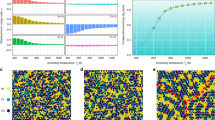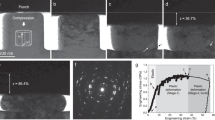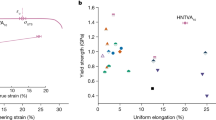Abstract
Magnesium is a lightweight structural metal but it exhibits low ductility—connected with unusual, mechanistically unexplained, dislocation and plasticity phenomena—which makes it difficult to form and use in energy-saving lightweight structures. We employ long-time molecular dynamics simulations utilizing a density-functional-theory-validated interatomic potential, and reveal the fundamental origins of the previously unexplained phenomena. Here we show that the key 〈c + a〉 dislocation (where 〈c + a〉 indicates the magnitude and direction of slip) is metastable on easy-glide pyramidal II planes; we find that it undergoes a thermally activated, stress-dependent transition to one of three lower-energy, basal-dissociated immobile dislocation structures, which cannot contribute to plastic straining and that serve as strong obstacles to the motion of all other dislocations. This transition is intrinsic to magnesium, driven by reduction in dislocation energy and predicted to occur at very high frequency at room temperature, thus eliminating all major dislocation slip systems able to contribute to c-axis strain and leading to the high hardening and low ductility of magnesium. Enhanced ductility can thus be achieved by increasing the time and temperature at which the transition from the easy-glide metastable dislocation to the immobile basal-dissociated structures occurs. Our results provide the underlying insights needed to guide the design of ductile magnesium alloys.
This is a preview of subscription content, access via your institution
Access options
Subscribe to this journal
Receive 51 print issues and online access
$199.00 per year
only $3.90 per issue
Buy this article
- Purchase on Springer Link
- Instant access to full article PDF
Prices may be subject to local taxes which are calculated during checkout





Similar content being viewed by others
References
Miller, W. S. et al. Recent development in aluminium alloys for the automotive industry. Mater. Sci. Eng. A 280, 37–49 (2000)
Kulekci, M. K. Magnesium and its alloys applications in automotive industry. Int. J. Adv. Manuf. Technol. 39, 851–865 (2008)
Heinz, A. et al. Recent development in aluminium alloys for aerospace applications. Mater. Sci. Eng. A 280, 102–107 (2000)
Pollock, T. M. Weight loss with magnesium alloys. Science 328, 986–987 (2010)
Hirth, J. P. & Lothe, J. Theory of Dislocations 2nd edn (Wiley & Sons, 1982)
Agnew, S. R. Deformation Mechanisms of Magnesium Alloys Ch. 2 63–104 (Woodhead Publishing, 2012)
Price, P. B. Nonbasal glide in dislocation-free cadmium crystals. II. The system. J. Appl. Phys. 32, 1750–1757 (1961)
Stohr, J. F. & Poirier, J. P. Etude en microscopie electronique du glissement pyramidal dans le magnesium. Phil. Mag. 25, 1313–1329 (1972)
Obara, T., Yoshinga, H. & Morozumi, S. slip system in magnesium. Acta Metall. 21, 845–853 (1973)
Koike, J. et al. The activity of non-basal slip systems and dynamic recovery at room temperature in fine-grained AZ31B magnesium alloys. Acta Mater. 51, 2055–2065 (2003)
Sandlöbes, S., Friák, M., Neugebauer, J. & Raabe, D. Basal and non-basal dislocation slip in Mg–Y. Mater. Sci. Eng. A 576, 61–68 (2013)
Yang, Z., Chisholm, M. F., Duscher, G., Ma, X. & Pennycook, S. J. Direct observation of dislocation dissociation and Suzuki segregation in a Mg–Zn–Y alloy by aberration-corrected scanning transmission electron microscopy. Acta Mater. 61, 350–359 (2013)
Yu, Q., Qi, L., Mishra, R. K., Li, J. & Minor, A. M. Reducing deformation anisotropy to achieve ultrahigh strength and ductility in Mg at the nanoscale. Proc. Natl Acad. Sci. USA 110, 13289–13293 (2013)
Geng, J., Chisholm, M. F., Mishra, R. K. & Kumar, K. S. The structure of 〈c + a〉 type dislocation loops in magnesium. Phil. Mag. Lett. 94, 377–386 (2014)
Kitahara, T., Ando, S., Tsushida, M., Kitahara, H. & Tonda, H. Deformation behavior of magnesium single crystals in c-axis compression. Key Eng. Mater. 345–346, 129–132 (2007)
Ando, S. & Tonda, H. Non-basal slips in magnesium and magnesium-lithium alloy single crystals. Mater. Sci. Forum 350–351, 43–48 (2000)
Tonda, H. & Ando, S. Effect of temperature and shear direction on yield stress by slip in HCP metals. Metall. Mater. Trans. A 33, 831–836 (2002)
Byer, C. M., Li, B., Cao, B. & Ramesh, K. T. Microcompression of single-crystal magnesium. Scr. Mater. 62, 536–539 (2010)
Syed, B., Geng, J., Mishra, R. K. & Kumar, K. S. [0001] compression response at room temperature of single-crystal magnesium. Scr. Mater. 67, 700–703 (2012)
Price, P. B. Pyramidal glide and the formation and climb of dislocation loops in nearly perfect zinc crystals. Phil. Mag. 5, 873–886 (1960)
Agnew, S. R., Horton, J. A. & Yoo, M. H. Transmission electron microscopy investigation of 〈c + a〉 dislocations in Mg and α–solid solution Mg-Li alloys. Metall. Mater. Trans. A 33, 851–858 (2002)
Bettles, C. J., Gibson, M. A. & Zhu, S. M. Microstructure and mechanical behaviour of an elevated temperature Mg-rare earth based alloy. Mater. Sci. Eng. A 505, 6–12 (2009)
Hidalgo-Manrique, P. et al. Origin of the reversed yield asymmetry in Mg-rare earth alloys at high temperature. Acta Mater. 92, 265–277 (2015)
Yoo, M. H., Agnew, S. R., Morris, J. R. & Ho, K. M. Non-basal slip systems in HCP metals and alloys: source mechanisms. Mater. Sci. Eng. A 319–321, 87–92 (2001)
Edelin, G. & Poirier, J. P. Etude de la montée des dislocations au moyen d’expriénces de fluage par diffusion dans le magnésium. Phil. Mag. 28, 1203–1210 (1973)
Wu, Z., Francis, M. F. & Curtin, W. A. Magnesium interatomic potential for simulating plasticity and fracture phenomena. Model. Simul. Mater. Sci. Eng. 23, 015004 (2015)
Henkelman, G. & Jónsson, H. Improved tangent estimate in the nudged elastic band method for finding minimum energy paths and saddle points. J. Chem. Phys. 113, 9978–9985 (2000)
Henkelman, G., Uberuaga, B. P. & Jónsson, H. A climbing image nudged elastic band method for finding saddle points and minimum energy paths. J. Chem. Phys. 113, 9901–9904 (2000)
Kocks, U. F., Argon, A. S. & Ashby, F. Thermodynamics and kinetics of slip. Prog. Mater. Sci. 19, 1–291 (1975)
Devincre, B., Hoc, T. & Kubin, L. Dislocation mean free paths and strain hardening of crystals. Science 320, 1745–1748 (2008)
Bertin, N., Tomé, C. N., Beyerlein, I. J., Barnett, M. R. & Capolungo, L. On the strength of dislocation interactions and their effect on latent hardening in pure magnesium. Int. J. Plast. 62, 72–92 (2014)
Wu, Z. & Curtin, W. A. Brittle and ductile crack-tip behavior in magnesium. Acta Mater. 88, 1–12 (2015)
Leyson, G. P. M., Curtin, W. A., Hector, L. G. & Woodward, C. F. Quantitative prediction of solute strengthening in aluminium alloys. Nature Mater. 9, 750–755 (2010)
Sandlöbes, S. et al. The relation between ductility and stacking fault energies in Mg and Mg–Y alloys. Acta Mater. 60, 3011–3021 (2012)
Sandlöbes, S. et al. Ductility improvement of Mg alloys by solid solution: ab initio modeling, synthesis and mechanical properties. Acta Mater. 70, 92–104 (2014)
Kang, F., Liu, J. Q., Wang, J. T. & Zhao, X. The effect of hydrostatic pressure on the activation of non-basal slip in a magnesium alloy. Scr. Mater. 61, 844–847 (2009)
Faken, D. & Jónsson, H. Systematic analysis of local atomic structure combined with 3D computer graphics. Comput. Mater. Sci. 2, 279–286 (1994)
Acknowledgements
Z.W. acknowledges financial support from the Agency for Science, Technology and Research (A*STAR), Singapore. W.A.C. acknowledges support of this work through a European Research Council Advanced Grant, ‘Predictive Computational Metallurgy’, ERC grant agreement no. 339081 – PreCoMet. W.A.C. also acknowledges earlier long-term support of Mg research from General Motors Corporation that provided the basis for research reported here.
Author information
Authors and Affiliations
Contributions
Z.W. and W.A.C. designed the research, analysed the data, developed the model, discussed the results, and wrote the paper. Z.W. performed the molecular dynamics simulations.
Corresponding author
Ethics declarations
Competing interests
The authors declare no competing financial interests.
Extended data figures and tables
Extended Data Figure 1 Dislocation core structures.
Pyramidal II 〈 c + a 〉 edge dislocation (top) and screw dislocation (bottom) core structures predicted by the modified embedded-atom method (MEAM) potential and DFT as visualized by the component of the Nye tensor and differential displacement plots26. The circles depict atoms projected onto the plane perpendicular to the dislocation line direction with the crystallographic orientation of the x and y axes shown (a is the lattice parameter of the hcp unit cell). In each image, the distribution of colour represents the distribution of the Nye tensor component (in units of Å−1), that is, the distribution of infinitesimal dislocation Burgers vector; the arrows represent the relative displacement component between two neighbouring atoms. At the dislocation cores, similarities in the distributions of colour and patterns of arrows between MEAM and DFT suggest similarities in atomic structures predicted by the two models. Figure from ref. 26 (http://dx.doi.org/10.1088/0965-0393/23/1/015004), copyright IOP Publishing. Reproduced with permission. All rights reserved.
Extended Data Figure 2 Distribution of pyramidal 〈c + a〉 edge dislocation transition type at different applied stresses.
At zero or low applied stresses, basal 〈 c + a 〉 is dominant (blue), while partial 〈a〉 and 〈c〉 (orange) or full 〈a〉 and 〈c〉 (red) dislocations are dominant at high applied stresses.
Extended Data Figure 3 Atom trajectories during transition from pyramidal II 〈c + a〉 to basal 〈c + a〉 at 500 K.
Each white line traces individual atom trajectory during the transition. No vacancy/interstitial diffusion from the bulk is involved during the transition. Atoms and trajectories are projected onto the plane perpendicular to the dislocation line direction (see Fig. 1 caption for colour representation).
Extended Data Figure 4 Schematics and coordinate system for 〈c + a〉 dislocation transition.
The 〈 c + a 〉 edge dislocation dissociated with a stacking fault (shown pink) on the pyramidal II plane (shown green) climb-dissociates into the basal plane with an I1 stacking fault (shown blue). The pink solid arrow and blue dashed arrows indicate the relevant 〈 c + a 〉 Burgers vectors before and after climb-dissociation. ξ indicates the dislocation line direction and x1, x2, and x3 are the Cartesian coordinate system used for calculating dislocation elastic energy.
Extended Data Figure 5 Pyramidal II 〈c + a〉 edge dislocation dissociation.
Shown are details of the dissociation of the easy-glide pyramidal II 〈 c + a 〉 into basal-dissociated products as observed during long-time MD simulations, for a, zero, b, moderate, and c, high compressive stresses normal to the pyramidal II plane. Dislocation cores are indicated by the symbol ‘⊥’. See Supplementary Information V for details of the dislocation reactions and Burgers vectors.
Extended Data Figure 6 Transition probability distribution for the random 〈c + a〉 transition processes.
P is the cumulative transition probability,  is the mean transition time, and ti indicates the ordered transition times from smallest to largest, t1 < t2 < ⋅⋅⋅ < tN. See Supplementary Information VII for details.
is the mean transition time, and ti indicates the ordered transition times from smallest to largest, t1 < t2 < ⋅⋅⋅ < tN. See Supplementary Information VII for details.
Extended Data Figure 7 Energy of 〈c + a〉 dislocations calculated within a cylindrical region of radius r.
a, Schematic showing the total dislocation energy consisting of near-core energy Estruc and far-field elastic energy Kln(r/rmin), where rmin ≈ 6b = 6|c + a|. b, The four dislocation energies (dashed lines, top to bottom) correspond respectively to the 〈 c + a 〉 edge dislocation on the pyramidal II plane, edge 〈c〉 and 〈a〉 in close proximity, 〈 c + a 〉 edge dislocation climb-dissociated on the basal plane, and the 〈 c + a 〉 screw dislocation on the pyramidal II plane. The edge dislocations with different core configurations have different energy density within rmin but the same far-field elastic energy scaling K. The screw dislocation has both lower energy within rmin and lower elastic energy scaling than do all the edge dislocations. The analytical energy prefactors K (the slope) from the anisotropic elastic solution are also shown (solid lines).
Extended Data Figure 8 Glide behaviour of the various dislocations under resolved shear stresses (directions indicated) at 300 K.
a, Easy-glide pyramidal II 〈 c + a 〉 at ∼13 MPa and 11 MPa with a distinct directional dependence. b, Glide of the basal-dissociated 〈 c + a 〉 but at very high stresses, ∼330 MPa. c, Glide of the 〈a〉 dislocation away from the remaining 〈 c + a 〉 product at ∼119 MPa, leaving an immobile 〈c〉, and reaction of 〈a〉 and 〈c〉 forming the basal 〈 c + a 〉 dislocation. d, Nucleation of partial 〈a〉 dislocations at 400–600 MPa from the immobile basal-dissociated 〈c〉 dislocation.
Supplementary information
Supplementary Information
This file contains Supplementary Text and Data and additional references. (PDF 298 kb)
Rights and permissions
About this article
Cite this article
Wu, Z., Curtin, W. The origins of high hardening and low ductility in magnesium. Nature 526, 62–67 (2015). https://doi.org/10.1038/nature15364
Received:
Accepted:
Published:
Issue Date:
DOI: https://doi.org/10.1038/nature15364
This article is cited by
-
Unravelling the jerky glide of dislocations in body-centred cubic crystals
Nature Materials (2024)
-
Macro-scale Compositional Inhomogeneity in Friction Stir Processed Mg–Al–Zn Cast Alloy and Its Effect on Mechanical Property
Metallurgical and Materials Transactions A (2024)
-
A Review on Factors Influencing Solidification Cracking of Magnesium Alloys During Welding
Metals and Materials International (2024)
-
Developing a High Ductility Mg Alloy Via Non-basal Slips and Intergranular Coordination Induced by Li and Er Addition
Metals and Materials International (2024)
-
Unlocking the Mechanism for Achieving Excellent Thermal Stability in Ultra-Thin AZ61 Mg Alloy Foil
Metallurgical and Materials Transactions A (2024)
Comments
By submitting a comment you agree to abide by our Terms and Community Guidelines. If you find something abusive or that does not comply with our terms or guidelines please flag it as inappropriate.



